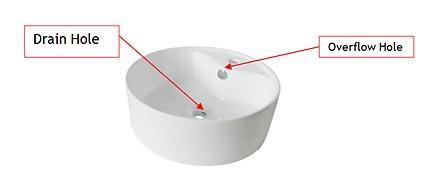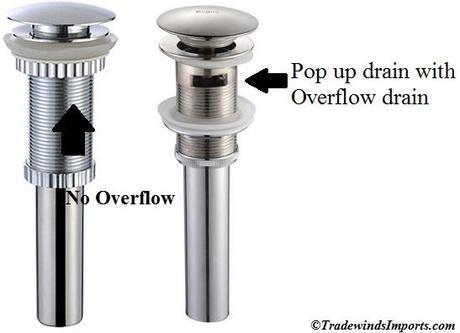The overflow drain is a plumbing feature that is added to prevent your sink or bathtub from overflowing with water in case of a clog. For both the bathtub and the sink over you vanity, the overflow operates in the same way. For educational purposes, we will use the example of the sinks overflow drain in this article.
Most bathtubs and sinks are equipped with one of these secondary drains. You have your primary drain, located at the bottom of the basin, and the overflow drain that is located along the side wall of the basin.

Here you can see how the overflow drain works. Sometimes, this drain can emit an odor if it get dirty. Source: Ask Me Help Desk
How it Works
The secondary drain allows water to flow out of your basin and down sewer lines. The overflow drain is normally located on the opposite side of the faucet along the upper wall. In other cases, the overflow drain can be found directly below the faucet.
The overflow drain is a hole that allows water to still flow to out of your basin even if the drain in your basin is clogged. It is located around the upper rim so that you can still fill your sink without a constant loss of water. This hole is routed through the inside of your vanity via small hoses and into the same pipe that the basin drain flows to. The overflow drain is connected below the drain to avert water from a backed up area.
What the Overflow Drain Does
- The primary purpose of the overflow drain is to help your sink drain faster. Imagine dumping out a 2 liter soda bottle. As the water exits, it will create a suction that causes the bottle to contract unless air is allowed in. If you poked a hole in the bottle, air would be able to replace the liquid mass and the soda would drain smoothly and at a constant rate. In the same way, the overflow drain helps your sink drain faster.
- Secondary drains work in coordination with the primary drains to prevent flooding. Overflow drains are an emergency feature that is intended to prevent flood damage from being caused to the surrounding area in your bathroom. In case you forget and leave the water running, the overflow drain will allow water to drain.

Here you can see the overflow drain located along the backside wall of the basin.
Vessel Sinks
Vessel sinks are unique in that they usually don’t have an overflow drain. For this reason, they tend to drain slower and result in bubbles coming from the drain when water is draining down the sink. Conventional undermounted sinks typically come with an overflow drain. View Examples.
Selecting the Right Drain
Knowing whether your sink has an overflow drain is important when selecting your drain. Drains can be purchase with or without overflow drains and they WILL NOT work interchangeably. You can find these types of drains at your local hardware stores like Home Depot and Lowes.

On the right you can see that the overflow drain has a small hole whereas a vessel sink drain does not have a hold for the overflow.
About the Author
This post was written on behalf of Tradewinds Imports by Cheryl Khan who is a contributing author to the TWI Blog. An interior designer by trade, she enjoys writing on her downtime. One place that she would like to visit in her lifetime is Cabo!
